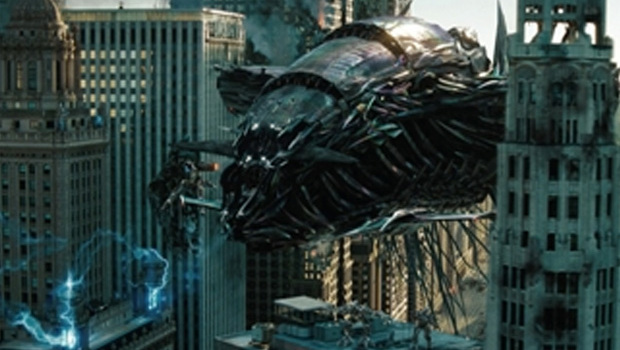The Biz Interview: Richard Johnson of “Transformers: Dark of the Moon”
Richard Johnson has a long and colourful history as an art director, which dates back in Hollywood to 1989 when he collaborated with Oliver Stone on Born on the Fourth of July. Since then, he has worked with a who’s-who of filmmakers, including Tim Burton, Ben Stiller, Steven Spielberg, and The Coen Brothers.
Transformers: Dark of the Moon represents Richard’s first project for director Michael Bay and he graciously took the time out to discuss his work on the film and insights into the industry of being an art director in Hollywood.
What general elements in Transformers: Dark of the Moon can audiences pick out as being your work?
The streets of Chicago. The vast piles of debris… The physical elements were largely set in place by myself and [Nigel Phelps] on a day-to-day, week-to-week basis. It’s a massive undertaking to take what is an intact, beautiful city and make it look like what it looks like in that movie.
What would you say is the most challenging element of the film for you and what are you most proud of as far as what you accomplished on it?
Everybody contributes as much as they can and I’ve gotta say the overall look of the film is what I’d say I’m most proud of. It looks spectacular. It’s shot brilliantly by Amir (Mokri) and Michael (Bay). It’s pretty amazing to take a present-day world and make it look like that. The moon was the other thing. I didn’t have a huge hand in it. I helped develop the actual dust that was on the moon – the whole surface of the moon. It was a big deal.
What was the most difficult thing to put together?
I think the spacecraft. We were dealing with a world that was glimpsed at in the previous two films – the Autobot spacecraft that crashed on the moon. It was a complicated thing to visualize and pull together. I suppose Chernobyl. They go to the bowels of Chernobyl and what does that really look like? A handful of Russians know what that is and the rest of the world will never know. We’re not going to get there.
You’ve worked on so many film projects and they’ve ranged a lot as far as budget and genre. How does your approach change if you’re doing an action film like Transformers: Dark of the Moon vs. a drama like State of Play or a comedy like Tropic Thunder?
Transformers is a very fast-paced film where you want to do things in broad strokes because (Michael) Bay’s constantly cutting from one angle to another angle to a different angle and [with] his rhythm, you’ve gotta have something visual back there that helps the rhythm and doesn’t confuse the audience… In his films, the action itself is its own character. In say The Road to Perdition, that’s all about invoking the time and the place and Chicago in the 1930s. Oddly enough (it) was shot where Transformers was and it was a whole different approach there. It was muted colour and it was also to set a tone of The Depression and the feeling of what it was like in the ’30s. It was very desaturated, not because we were cutting it quickly, but because that was the feeling Sam Mendes was going for… Then there’s Tropic Thunder where it’s all about a mockumentary (of) what Hollywood does when they make movies… [Tropic Thunder] is more about having a good time, so you can be a lot looser and freer about things in a comedy.
You have a huge range of filmmakers that you’ve worked with – Michael Bay, Oliver Stone, The Coen Brothers, and Tim Burton to name a few. What are the keys to a successful collaboration between an art director and a film director in your experience?
It’s really tough. You’ve got to do a lot of listening. A director will come to you to help. Your job is to help realize their vision. It varies director to director. For instance, Tim (Burton) pretty darn well knows what he wants his films to look like and you’ve really got to pay attention to him and listen to what Tim’s doing and trying to do, then just help him get there with that as much as you possibly can, and just be patient and bring your skills to help him get what he’s after. Other directors like Ben Stiller – he’s not as visually-driven as someone like Tim, so you can [collaborate] a lot more with somebody like that… It’s all incumbent on someone like me to really pay attention and listen to what these guys are trying to do cause they’re the captain of the ship. To be a good crew member, you have to follow the captain.
What inspired you to get started to become an art director to begin with? What people or films influenced you the most?
A lot of European filmmakers, Bergman in particular. I’m Swedish by birth and his style of filmmaking is spectacular, in my opinion. There’s nobody today that even gets half close of that… Initially, I wanted to be an architect and found architecture to be a really closed loop – not that filmmaking isn’t, but as a designer and creator of architecture, you can really do a lot more in a hell of a lot quicker time in the film business. The palette’s so much bigger.
What advice would you give to people who are interested in working as an art director?
I would tell them to get a very, very, very strong background in graphics design and architecture. Proportion is the single most important thing a designer can have and there’s a hell of a lot of people out there that don’t know anything at all about proportions that are trying to be designers and it’s frustrating. It’s very key to the success of a look is proportion and balance and it’s taught best to graphics designers…. Study photography. It’s all about the look. Follow the world of photography – modern photography. Somebody like Annie Leibovitz, her images are striking. Or Mary Ellen Mark – she’s another brilliant, brilliant photographer. Just how they compose and what they do – and what’s that background doing because their eyes are following that background. Don’t for a second think that it’s just about the foreground. .. There’s a lot that goes into these films that the average person in the audience would never imagine.
Transformers: Dark of the Moon is in theatres now.


















